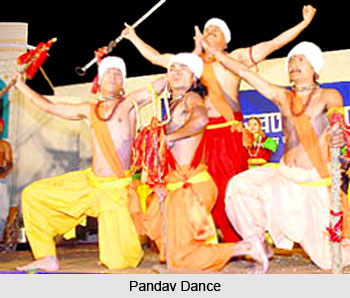 The culture of Uttarkashi District takes its league from the Pandava culture since ancient times. Though majority of the population observe the same social values still different parts depict variety in cultural heritage. Several fairs are also organised in the district that form an integral part of the culture of Uttarkashi District. Magh Mela is the most popular fair of Uttarkashi. The fair starts on the occasion of Makar Sankranti of Magha month. Dolis of local gods and goddesses are brought to Uttarkashi from their native places. The fair continues for a week. People from all around the district and other parts as well come to participate in the fair. The land of Uttarkashi has been held sacred by Indians since ages: this is where the seers and sages found solace and performed penance. Spirituality and religion is deeply rooted in Uttarkashi.
The culture of Uttarkashi District takes its league from the Pandava culture since ancient times. Though majority of the population observe the same social values still different parts depict variety in cultural heritage. Several fairs are also organised in the district that form an integral part of the culture of Uttarkashi District. Magh Mela is the most popular fair of Uttarkashi. The fair starts on the occasion of Makar Sankranti of Magha month. Dolis of local gods and goddesses are brought to Uttarkashi from their native places. The fair continues for a week. People from all around the district and other parts as well come to participate in the fair. The land of Uttarkashi has been held sacred by Indians since ages: this is where the seers and sages found solace and performed penance. Spirituality and religion is deeply rooted in Uttarkashi.
Folk songs and folk dances contribute heavily to the culture of Uttarkashi District. The society has preserved its culture, folklore, folk songs and folk dances since ages. The dances are seasonal, traditional and religious. Thadiya dance is performed on Vasant Panchami to herald the onset of spring. Mela dance is performed on Diwali and the Pandav dance during the winters after the crops are harvested and it depicts the events of the Mahabharata. Other dances are also performed to enact mythological stories, where men and women, dressed colourfully, dance to the tunes of the drums and other musical instruments. Pona dance is performed during marriages and parties. Folk songs are usually traditional and are generally sung by the womenfolk. Fairs, festivals, religious and social gatherings are occasions for socialising, recreation and amusement. People arrange swangs (open-air performances), which generally portray legends associated with Lord Shiva and Parvati. Festivals play an important role in the life of people. Major festivals celebrated by people include Makar Sankranti, Ramnavami, Janmashtami, Nag Panchami, Raksha Bandhan, Dussehra, Diwali, Shivaratri, and Holi. Other festivals include Baisakhi, Lohri, and some regional festivals.
The folk dance called `Pandav Nritya` which is based on the episodes of Mahabharata is popular in the rural areas. `Raso Nritya` is also widely popular in the district. Tandi Nritya, Jhumalo Nritya, Paisara Nritya, Doli Nritya etc. are some other popular folk dances in the Rawai region of the district. Among the folk songs Mangalgeet, Vivahgeet, Poojangeet, Thadyageet, Jhumaila, Basant, Baju Band, Khudergeet, Chafula, Chaitigeet, Baramasigeet etc. are quite popular.
The most common language spoken in the district is Garhwali language, which belongs to the group of Indo-Aryan languages and is a form of Hindi language. It is a part of central Pahari, which is related to Kumaoni language but is influenced by eastern Rajasthani language, Punjabi language and Hindi due to early immigration of Rajputs and others from the plains.



















